Abstract
A Register of HIV-infected persons who have had a negative antibody test within 3 years of their first antibody positive test (seroconverters) is being set up in the UK to monitor the distribution of times from HIV seroconversion to AIDS (the incubation period) and to death. It will also provide a national resource for use by those designing studies in this group of individuals. Clinicians caring for HIV-positive persons in Genito-Urinary Medicine, Infectious Disease and other departments throughout the UK were asked to participate by providing information on eligible subjects. Most laboratories undertaking HIV antibody testing were also contacted and asked to provide the name of the attending clinician for all seroconverters identified through the HIV laboratory reporting systems of the PHLS Communicable Disease Surveillance Centre (CDSC) and the Scottish Centre for Infection and Environmental Health (SCIEH) and for any other seroconverters known to them but not identified by CDSC or SCIEH. Data items sought for the Register include: sex, ethnic group, probable route of HIV transmission, annual CD4 counts, details of therapy and prophylaxis prescribed, AIDS-defining events and vital status. Follow up information is collected annually. Wherever possible, all seroconverters known to a clinic have been identified, whether currently alive or dead, either from clinic records or laboratory reporting or both. The objective is to establish and update a complete register of seroconverters on a long-term to basis to provide reliable estimates of the incubation period on which future projections of AIDS cases in the UK can be made.
Full text
PDF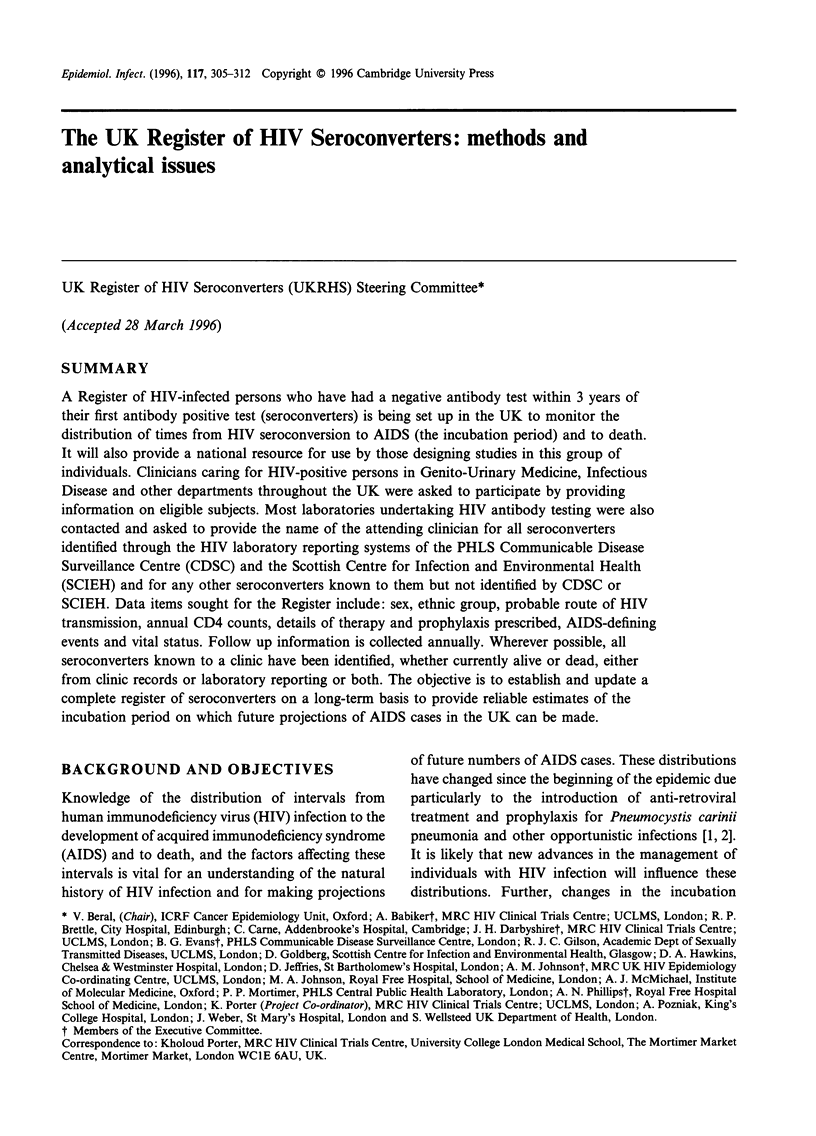
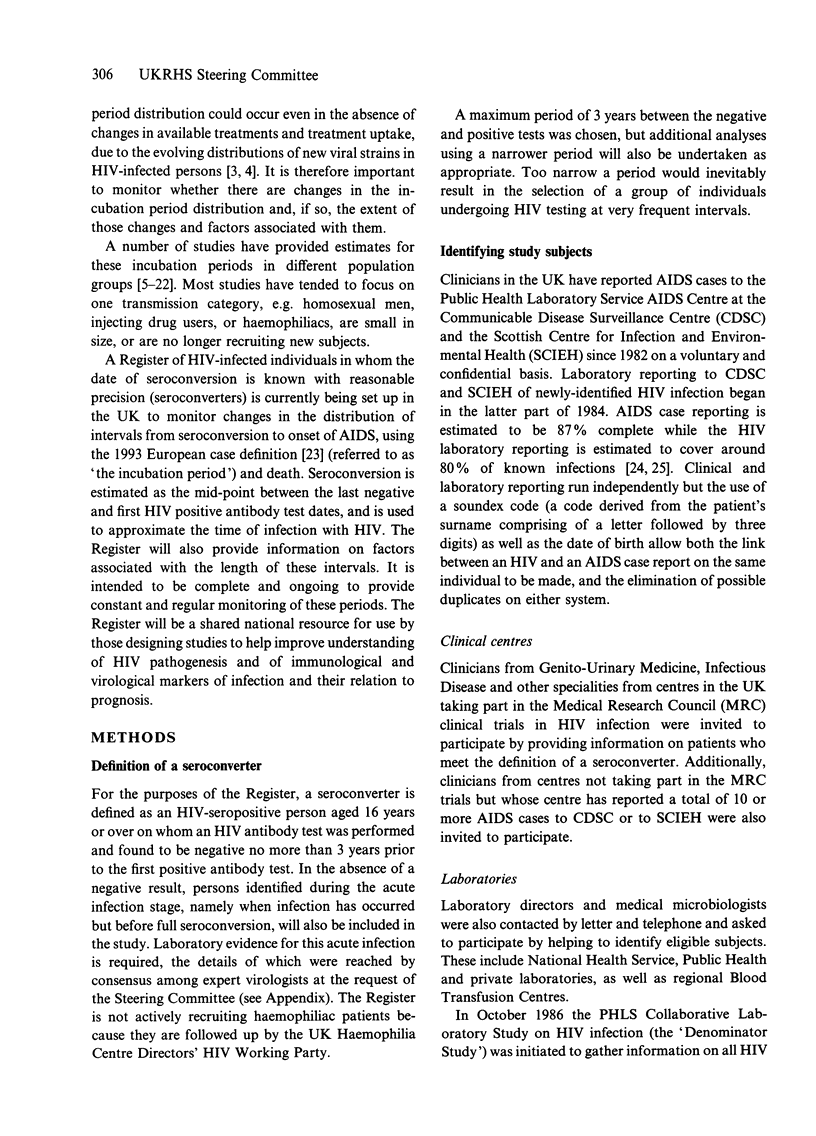
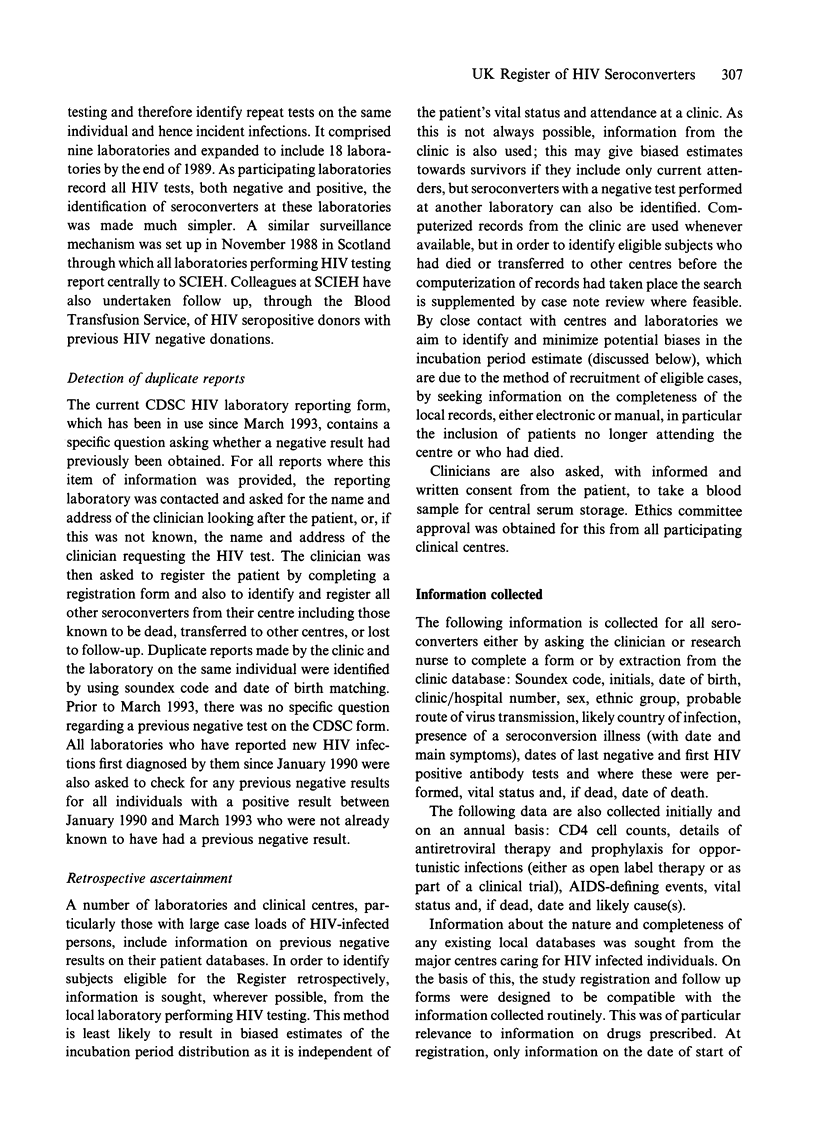
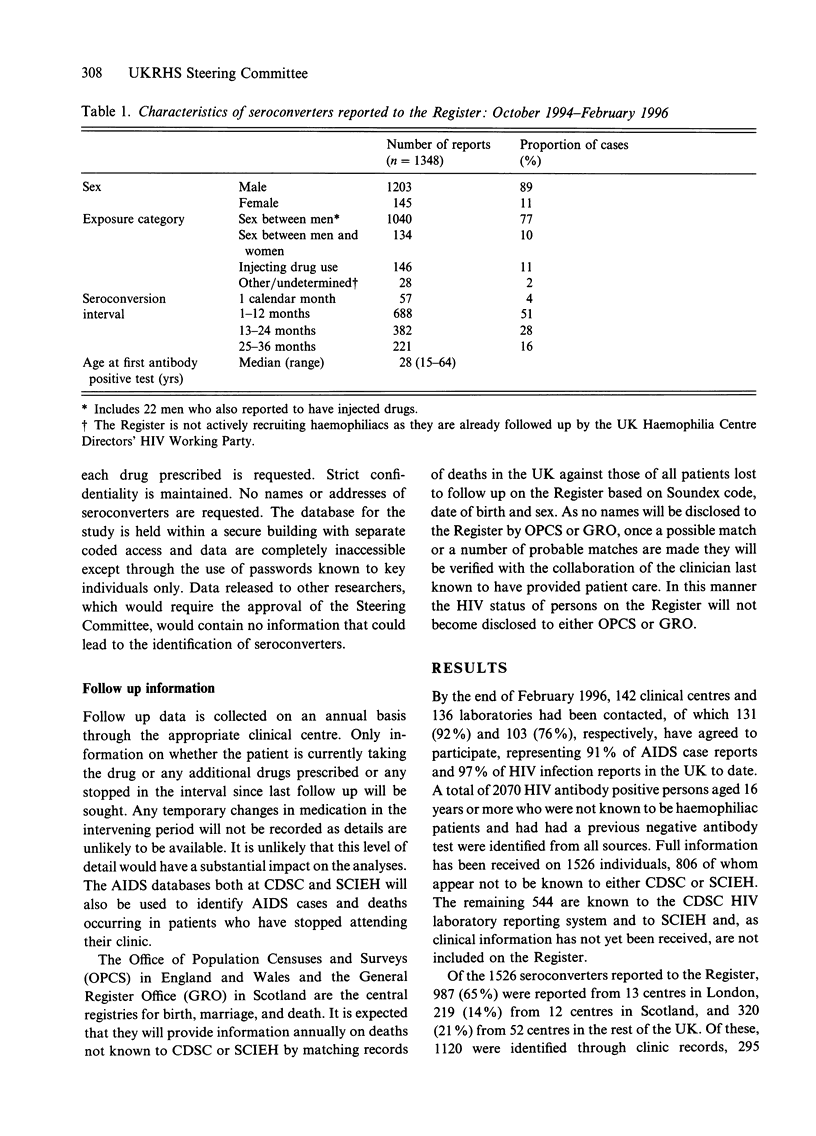
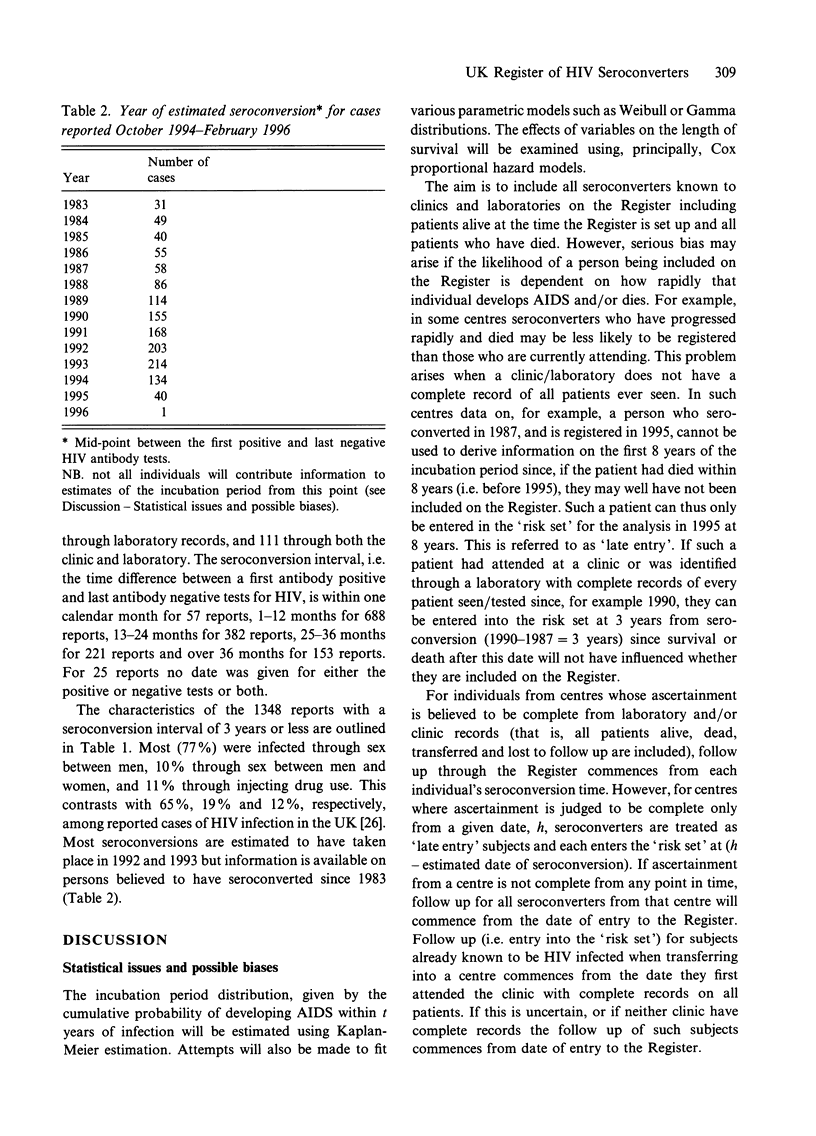
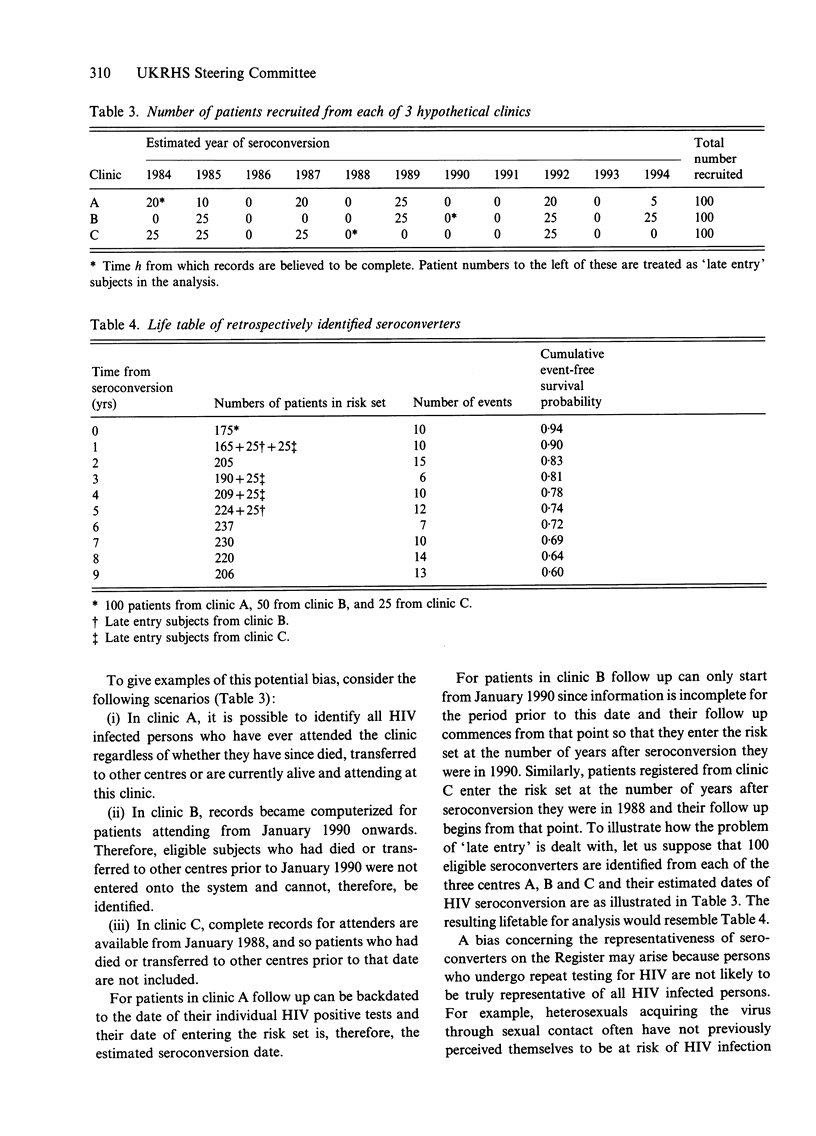
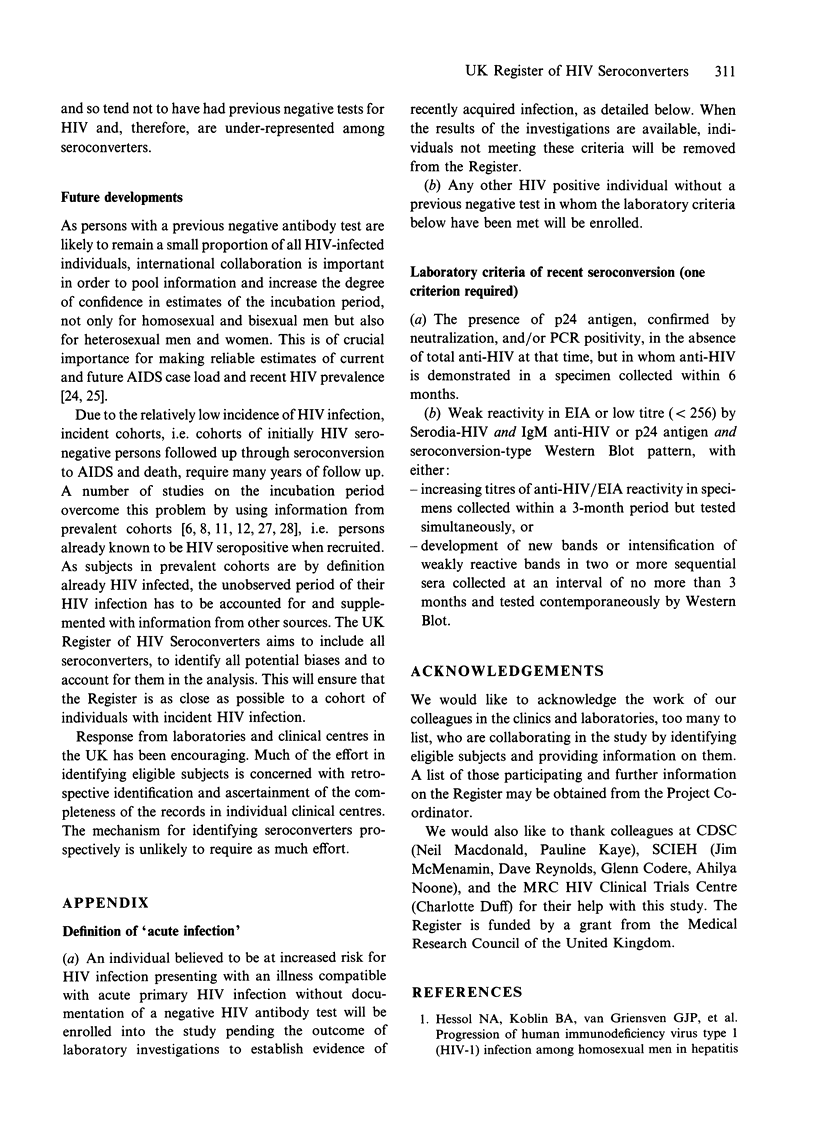
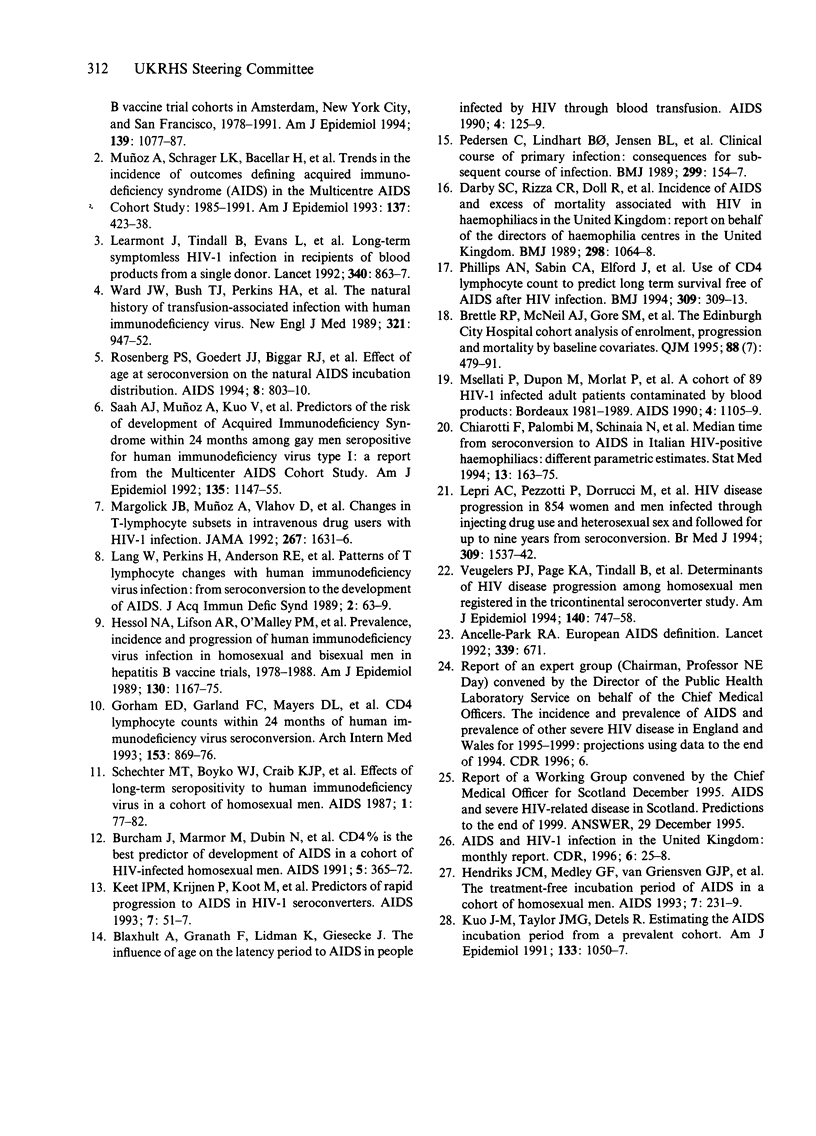
Selected References
These references are in PubMed. This may not be the complete list of references from this article.
- Blaxhult A., Granath F., Lidman K., Giesecke J. The influence of age on the latency period to AIDS in people infected by HIV through blood transfusion. AIDS. 1990 Feb;4(2):125–129. doi: 10.1097/00002030-199002000-00005. [DOI] [PubMed] [Google Scholar]
- Brettle R. P., McNeil A. J., Gore S. M., Bird A. G., Leen C. S., Richardson A. The Edinburgh City Hospital cohort: analysis of enrollment, progression and mortality by baseline covariates. QJM. 1995 Jul;88(7):479–491. [PubMed] [Google Scholar]
- Burcham J., Marmor M., Dubin N., Tindall B., Cooper D. A., Berry G., Penny R. CD4% is the best predictor of development of AIDS in a cohort of HIV-infected homosexual men. AIDS. 1991 Apr;5(4):365–372. doi: 10.1097/00002030-199104000-00002. [DOI] [PubMed] [Google Scholar]
- Chiarotti F., Palombi M., Schinaia N., Ghirardini A., Bellocco R. Median time from seroconversion to AIDS in Italian HIV-positive haemophiliacs: different parametric estimates. Stat Med. 1994 Jan 30;13(2):163–175. doi: 10.1002/sim.4780130207. [DOI] [PubMed] [Google Scholar]
- Cozzi Lepri A., Pezzotti P., Dorrucci M., Phillips A. N., Rezza G. HIV disease progression in 854 women and men infected through injecting drug use and heterosexual sex and followed for up to nine years from seroconversion. Italian Seroconversion Study. BMJ. 1994 Dec 10;309(6968):1537–1542. doi: 10.1136/bmj.309.6968.1537. [DOI] [PMC free article] [PubMed] [Google Scholar]
- Darby S. C., Rizza C. R., Doll R., Spooner R. J., Stratton I. M., Thakrar B. Incidence of AIDS and excess of mortality associated with HIV in haemophiliacs in the United Kingdom: report on behalf of the directors of haemophilia centres in the United Kingdom. BMJ. 1989 Apr 22;298(6680):1064–1068. doi: 10.1136/bmj.298.6680.1064. [DOI] [PMC free article] [PubMed] [Google Scholar]
- Enel P., Manuel C., Charrel J., Larher M. P., Reviron D., San Marco J. L. AIDS, a social dilemma: detection of seropositives. Eur J Epidemiol. 1991 Mar;7(2):139–146. doi: 10.1007/BF00237357. [DOI] [PubMed] [Google Scholar]
- Gorham E. D., Garland F. C., Mayers D. L., Goforth R. R., Brodine S. K., Wiess P. J., McNally M. S. CD4 lymphocyte counts within 24 months of human immunodeficiency virus seroconversion. Findings in the US Navy and Marine Corps. The Navy Retroviral Working Group. Arch Intern Med. 1993 Apr 12;153(7):869–876. [PubMed] [Google Scholar]
- Hendriks J. C., Medley G. F., van Griensven G. J., Coutinho R. A., Heisterkamp S. H., van Druten H. A. The treatment-free incubation period of AIDS in a cohort of homosexual men. AIDS. 1993 Feb;7(2):231–239. doi: 10.1097/00002030-199302000-00012. [DOI] [PubMed] [Google Scholar]
- Hessol N. A., Lifson A. R., O'Malley P. M., Doll L. S., Jaffe H. W., Rutherford G. W. Prevalence, incidence, and progression of human immunodeficiency virus infection in homosexual and bisexual men in hepatitis B vaccine trials, 1978-1988. Am J Epidemiol. 1989 Dec;130(6):1167–1175. doi: 10.1093/oxfordjournals.aje.a115445. [DOI] [PubMed] [Google Scholar]
- Keet I. P., Krijnen P., Koot M., Lange J. M., Miedema F., Goudsmit J., Coutinho R. A. Predictors of rapid progression to AIDS in HIV-1 seroconverters. AIDS. 1993 Jan;7(1):51–57. doi: 10.1097/00002030-199301000-00008. [DOI] [PubMed] [Google Scholar]
- Kuo J. M., Taylor J. M., Detels R. Estimating the AIDS incubation period from a prevalent cohort. Am J Epidemiol. 1991 May 15;133(10):1050–1057. doi: 10.1093/oxfordjournals.aje.a115814. [DOI] [PubMed] [Google Scholar]
- Lang W., Perkins H., Anderson R. E., Royce R., Jewell N., Winkelstein W., Jr Patterns of T lymphocyte changes with human immunodeficiency virus infection: from seroconversion to the development of AIDS. J Acquir Immune Defic Syndr. 1989;2(1):63–69. [PubMed] [Google Scholar]
- Learmont J., Tindall B., Evans L., Cunningham A., Cunningham P., Wells J., Penny R., Kaldor J., Cooper D. A. Long-term symptomless HIV-1 infection in recipients of blood products from a single donor. Lancet. 1992 Oct 10;340(8824):863–867. doi: 10.1016/0140-6736(92)93281-q. [DOI] [PubMed] [Google Scholar]
- Margolick J. B., Muñoz A., Vlahov D., Solomon L., Astemborski J., Cohn S., Nelson K. E. Changes in T-lymphocyte subsets in intravenous drug users with HIV-1 infection. JAMA. 1992 Mar 25;267(12):1631–1636. [PubMed] [Google Scholar]
- Msellati P., Dupon M., Morlat P., Lacoste D., Pellegrin J. L., Dabis F. A cohort study of 89 HIV-1-infected adult patients contaminated by blood products: Bordeaux 1981-1989. Groupe d'Epidémiologie Clinique du SIDA en Aquitaine (GECSA) AIDS. 1990 Nov;4(11):1105–1109. doi: 10.1097/00002030-199011000-00008. [DOI] [PubMed] [Google Scholar]
- Muñoz A., Schrager L. K., Bacellar H., Speizer I., Vermund S. H., Detels R., Saah A. J., Kingsley L. A., Seminara D., Phair J. P. Trends in the incidence of outcomes defining acquired immunodeficiency syndrome (AIDS) in the Multicenter AIDS Cohort Study: 1985-1991. Am J Epidemiol. 1993 Feb 15;137(4):423–438. doi: 10.1093/oxfordjournals.aje.a116691. [DOI] [PubMed] [Google Scholar]
- Pedersen C., Lindhardt B. O., Jensen B. L., Lauritzen E., Gerstoft J., Dickmeiss E., Gaub J., Scheibel E., Karlsmark T. Clinical course of primary HIV infection: consequences for subsequent course of infection. BMJ. 1989 Jul 15;299(6692):154–157. doi: 10.1136/bmj.299.6692.154. [DOI] [PMC free article] [PubMed] [Google Scholar]
- Phillips A. N., Sabin C. A., Elford J., Bofill M., Janossy G., Lee C. A. Use of CD4 lymphocyte count to predict long-term survival free of AIDS after HIV infection. BMJ. 1994 Jul 30;309(6950):309–313. doi: 10.1136/bmj.309.6950.309. [DOI] [PMC free article] [PubMed] [Google Scholar]
- Rosenberg P. S., Goedert J. J., Biggar R. J. Effect of age at seroconversion on the natural AIDS incubation distribution. Multicenter Hemophilia Cohort Study and the International Registry of Seroconverters. AIDS. 1994 Jun;8(6):803–810. doi: 10.1097/00002030-199406000-00013. [DOI] [PubMed] [Google Scholar]
- Saah A. J., Muñoz A., Kuo V., Fox R., Kaslow R. A., Phair J. P., Rinaldo C. R., Jr, Detels R., Polk B. F. Predictors of the risk of development of acquired immunodeficiency syndrome within 24 months among gay men seropositive for human immunodeficiency virus type 1: a report from the Multicenter AIDS Cohort Study. Am J Epidemiol. 1992 May 15;135(10):1147–1155. doi: 10.1093/oxfordjournals.aje.a116215. [DOI] [PubMed] [Google Scholar]
- Schechter M. T., Boyko W. J., Craib K. J., McLeod A., Willoughby B., Douglas B., Constance P., O'Shaughnessey M. Effects of long-term seropositivity to human immunodeficiency virus in a cohort of homosexual men. AIDS. 1987 Jul;1(2):77–82. [PubMed] [Google Scholar]
- Veugelers P. J., Page K. A., Tindall B., Schechter M. T., Moss A. R., Winkelstein W. W., Jr, Cooper D. A., Craib K. J., Charlebois E., Coutinho R. A. Determinants of HIV disease progression among homosexual men registered in the Tricontinental Seroconverter Study. Am J Epidemiol. 1994 Oct 15;140(8):747–758. doi: 10.1093/oxfordjournals.aje.a117322. [DOI] [PubMed] [Google Scholar]
- Ward J. W., Bush T. J., Perkins H. A., Lieb L. E., Allen J. R., Goldfinger D., Samson S. M., Pepkowitz S. H., Fernando L. P., Holland P. V. The natural history of transfusion-associated infection with human immunodeficiency virus. Factors influencing the rate of progression to disease. N Engl J Med. 1989 Oct 5;321(14):947–952. doi: 10.1056/NEJM198910053211406. [DOI] [PubMed] [Google Scholar]


